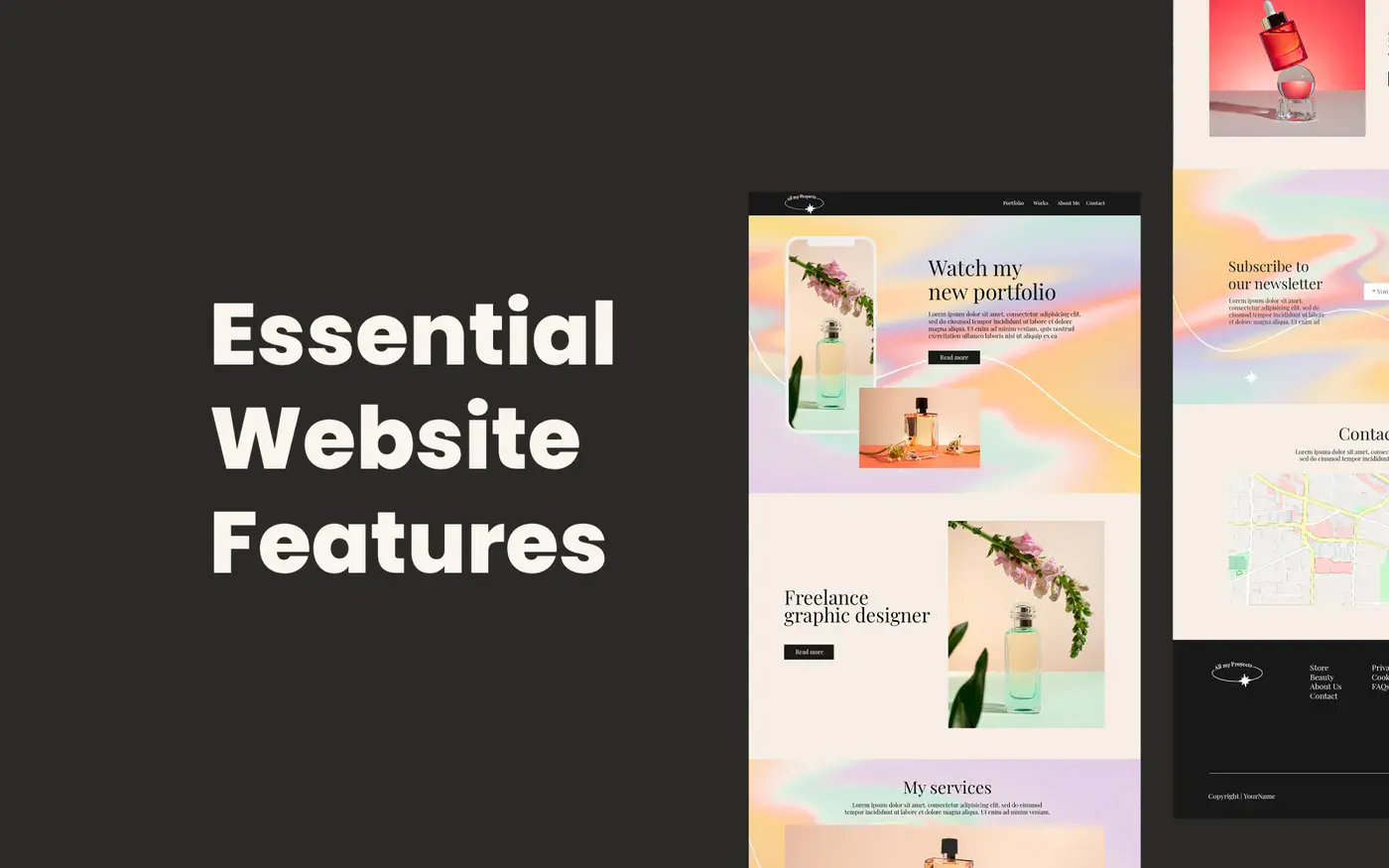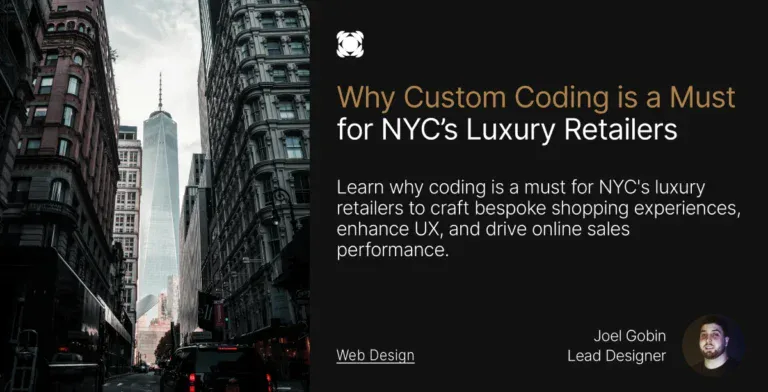Your website’s key features determine its success or failure in today’s digital marketplace. Businesses compete with over 2 billion websites.
But how do you know which website features are essential and which are just a waste of time?
This piece breaks down the essential website features that help businesses succeed online.
These range from homepage designs that create powerful first impressions to security measures that keep you and your customers safe.
Essential Website Features For Your Homepage
Your homepage works like a digital storefront that creates instant impressions and decides if visitors stay or leave. And great navigation is the foundation of a good website user experience that naturally guides visitors through your digital space.
Clear branding and logo placement
Logo placement affects brand recall a lot. Research shows that left-aligned logos create 89% better brand recall than right-aligned logos. This placement works best for left-to-right readers because their eyes naturally move to the left side first.
A logo in the top-left corner serves three key functions:
Reminds visitors which website they are browsing.
- Provides easy navigation back to the homepage.
- Reinforces brand recognition throughout the browsing experience.
An essential website features every website should have is good logo placement. It helps with navigation beyond recognition.
The logo needs enough white space around it as well. Visual separation from other elements helps users spot clickable text quickly.

Want to learn even more about branding?
Here’s our latest branding statistics article to help you understand current trends and metrics.
Search bar and user-friendly menu
One of the most essential website features you can have on your site is a smart search bar. Users like to search rather than browse through long menus.
This is especially true when they need specific information. The search bar should sit where users expect it—usually in the top right or top center of your web page.
Users recognize a magnifying glass icon best, as it saves space and shows purpose right away. Sites that rely mainly on search should use a bigger, centered search bar with helpful placeholder text to direct users.
The main navigation works best with seven items or fewer. Users pay most attention to items at the start and end of navigation menus, so put your key pages there.
Most marketing websites place their contact buttons in the top right corner, making it a marketing strategy standard that users now expect.
Calls to action that guide users
Strong CTAs guide visitors toward meaningful business engagement. Research shows customized CTAs convert 42% more visitors than generic ones. Strong action verbs at the start of your CTAs encourage quick responses.
Your CTAs should grab attention through:
Colors that stand out from the background.
- Placement above the fold.
- Short, action-focused text (keep it under five words).
Add two or three call-to-action buttons above the fold to help people at different buying stages. These elements should catch the eye with colors that contrast with your overall design while staying true to your aesthetic.
Internal links and homepage structure
Internal links create paths that help users and search engines understand your site layout. Google uses these links to find content and figure out page importance.
Pages with more internal links show higher value to search engines and might rank better.
Homepages usually carry the most link value because they get the most backlinks. New content linked directly from your homepage helps search engines find and index it faster.
Smart internal linking prevents “orphaned content.” This means no pages are left without links. Search engines can easily find all your content.
A clear hierarchy should direct users through your site logically. Your menu design needs to reflect this structure to help visitors feel oriented at all times.
Mobile-First and Responsive Design
Mobile devices have changed how users interact with websites. Smartphone screens now serve as the main window to your digital world.
Learning how to optimize your website for mobile experiences is vital if you want to succeed and grow nowadays.
Why mobile-first matters in 2025
Mobile devices generate over 60% of all web traffic. They lead the way people access the internet. This reality has changed how businesses approach web design.
Smart companies now focus on mobile first. They no longer try to fit desktop experiences onto smaller screens.
Google’s search algorithms have adapted to this new reality. The search giant now uses mobile-first indexing to rank and index websites. Your search visibility could drop if your site lacks proper mobile optimization.
Mobile optimization affects your profits as well. Users leave websites that take more than three seconds to load. Research shows pages loading in 2 seconds have an average 9% bounce rate. This number jumps to 38% when loading takes 5 seconds. Every second counts with mobile visitors.
Traffic statistics tell only part of the story. Mobile-first design pushes businesses to focus on what matters most. Small screens need tough choices about content priorities.
This often creates better experiences on all devices. It does this by removing distractions that could hurt your conversion goals.
Want a fast loading custom website but don’t know where to start? Let us help.
Responsive layout techniques
Responsive design adapts naturally to different screen sizes through several core techniques. Fluid layouts that use percentages instead of fixed pixels form the foundation. This allows containers to grow or shrink based on screen space.
Breakpoints act as key decision points where your design adjusts to different viewport widths.
Most responsive designs include breakpoints for mobile devices, tablets, and desktops. You can customize these to fit additional device types. Media queries in CSS spot these breakpoints and apply different styling rules.
The CSS Flexbox module has revolutionized responsive layouts. It offers a quicker way to arrange elements, even with unknown content size. A flex container grows items to fill space or shrinks them to prevent overflow. This works perfectly for different screen sizes.
Text needs special attention in responsive websites. Font sizes should change based on screen width to keep content readable without endless scrolling. Good typography ensures that content stays accessible on any device.
Touch-friendly navigation and gestures
Mobile users tap instead of click. This basic difference shapes navigation design. Desktop users look for main navigation at the top. Mobile interfaces should place key navigation elements near the bottom or middle where thumbs can easily reach.
Physical context shapes mobile design choices. Desktop users work with computers on surfaces. Mobile users hold devices in their hands. This changes how people use your interface.
Important links and calls-to-action belong in the center of mobile screens because thumbs struggle with corners and edges.
Gesture controls add depth to mobile experiences. Swipes, pinches, and taps can replace standard buttons to create a smooth, app-like feel. The best touch interfaces feel like physical objects.
Actions should feel natural rather than learned.
Smart gesture implementation matters. Progressive disclosure helps users learn controls as they move through your interface.
Quick feedback and subtle visual hints show available interactions without long tutorials. Business websites should mix gesture innovation with familiar patterns to keep visitors comfortable.
Performance and Speed Optimization
Website speed directly affects your bottom line. Users quickly judge websites, so performance optimization is key to a strong online presence.
Fast loading times and user retention
Loading speed plays a significant role in keeping visitors on your site. It is one of the most vital web design features of this article.
Website load times are especially important in competitive markets such as the startup industry in San Francisco.
Studies show that all but one of these visitors will leave if pages take more than three seconds to load. A single second delay in response time can reduce conversions by 7%.
Sites that load within one second convert up to 2.5 times more customers than their slower counterparts.
Speed’s effect on business results shows up consistently everywhere.
Image compression and lazy loading
Smart image optimization begins with proper sizing. Using a 1000px image where you only need 100px wastes resources. Quality-preserving compression is also vital, with tests showing at least 10% faster loading time through proper optimization.
Lazy loading changes how your page handles resources. This technique loads non-critical images only when users scroll near them. The process works by:
Loading only visible (above-the-fold) content initially.
- Deferring off-screen images until needed.
- Reducing initial page weight dramatically.
Using AMP for mobile performance
Accelerated Mobile Pages (AMP) provide a powerful way to optimize speed. This open-source framework removes unnecessary elements from pages and focuses on content delivery.
AMP pages load 85% faster than regular pages through several methods:
Enforcing asynchronous JavaScript that does not block rendering.
- Limiting CSS to 50KB and requiring inline styling.
- Caching pages through Google’s AMP cache.
- Eliminating render-blocking resources.
Results speak for themselves—companies like Vodafone saw an 8% increase in sales after implementing AMP. This speed advantage becomes crucial for mobile users who have limited bandwidth or slower connections.
Modern User Experience Features
When thinking about essential website features, it’s hard to ignore modern UX ones. Users now expect comfort features beyond simple website functionality.
These additions have become competitive necessities rather than luxuries.
Dark mode toggle and visual comfort
Dark mode helps reduce eye strain when users browse in low-light environments. It works by switching color schemes from light backgrounds with dark text to dark backgrounds with light text.
This feature makes websites more accessible to users with visual impairments and reduces eye fatigue during long website visits.
The advantages go beyond comfort. Devices with OLED or AMOLED displays use less battery power with dark mode since darker pixels need less power than brighter ones.
Mobile visitors watching their battery life will find your site more user friendly.
Most major websites now include this feature as standard. Users expect this level of customization, and dark mode has moved from a trend to a must-have feature.
Voice user interface for accessibility
Voice user interfaces (VUIs) make websites more accessible through natural language interaction. These interfaces help users with various disabilities, including visual, motor, and cognitive impairments.
VUIs work as assistive technology that enables hands-free, eyes-free interaction with your website. Users with motor impairments who find traditional input devices challenging can use voice commands as a vital alternative way to navigate.
Building an effective VUI means understanding how people naturally speak.
Here’s what matters most:
Support for different speech patterns, including regional accents and speech affected by physical disabilities.
- Visual feedback options that help users with hearing impairments.
- Text alternatives for voice inputs and outputs.
- Simple, consistent conversation flows that work for users with cognitive impairments.
AI-powered chatbots for instant support
AI chatbots improve customer support by offering 24/7 help without adding more staff. Modern AI agents manage complex requests using natural language understanding. This is different from simple, scripted bots.
Smart chatbots connect to your knowledge base. They pull accurate info about products, policies, or services. This connection creates tailored responses that match specific customer needs instead of generic answers.
Setting up these systems has become easier. Many platforms now offer no-code builders that connect to your existing knowledge base. You can deploy them in minutes instead of weeks.
Combining your chatbot with analytics tools leads to the best results. These tools enhance responses by learning from real customer interactions. This approach creates a better support system. It boosts customer loyalty by offering personalized help.
Security and Backend Essentials
Security is the foundation of website trustworthiness. This is one of the most non-negotiable and essential website features on this list.
Every successful online business needs a reliable security infrastructure to protect both company and customer data from sophisticated threats.
SSL certificates and HTTPS
If there is a feature, HTTPS encrypts data between browsers and your website. This encryption stops bad actors from intercepting information easily.
SSL certificates are at the heart of HTTPS security. These certificates contain your website’s public key and identity details. They confirm your site’s authenticity and enable encrypted connections through asymmetric public key infrastructure. Your public key encrypts information, but only your private key can decrypt it. This creates a secure channel to transfer sensitive data.
HTTPS does more than just encrypt data. It stops third parties from adding content to your webpages without permission. Some ISPs try to insert ads into customer websites, but HTTPS makes this impossible and keeps your site’s integrity intact.
Google and other browsers mark non-HTTPS websites as “not secure.” This visual warning substantially affects user trust.
This is especially important for industries where security is of the utmost important. A law firm website without any security can be seen as a red flag for most people for example.
Users feel safe when they see a padlock icon in the URL bar because they know their information stays protected.
Data protection and compliance
Security decisions now revolve around regulatory compliance. The GDPR, several years old, sets strict requirements for businesses that handle EU citizen data. These rules require websites to use proper technical safeguards and organizational measures to protect user information.
Good data protection needs encryption, pseudonymization, and strong access controls. Security audits help find and fix potential vulnerabilities before they become issues.
The data minimization principle helps create genuine security. You should only collect information you really need from users. Let visitors know exactly how you’ll use and store their data at every collection point. This builds trust and ensures compliance.
GDPR requires you to notify authorities within 72 hours of data breaches. You need detailed records of all data collection processes and clear response protocols to prepare for this possibility.
Two-factor authentication and secure logins
Single-factor authentication is like having one basic lock on your door. Two-factor authentication (2FA) adds another layer of verification that substantially reduces account takeover risks.
The most secure 2FA methods include:
Authenticator apps: Apps like Google Authenticator or Microsoft Authenticator create time-sensitive verification codes. These apps work better than SMS verification because SIM-swap attacks cannot compromise their security.
- Security keys: Physical devices with encryption provide the strongest authentication. They connect through USB or NFC to verify your identity without sending credentials that hackers might steal.
- SMS verification: Text message verification is convenient but vulnerable to phone number attacks. It still offers better protection than passwords alone if it’s your only option.
2FA protects your administrative accounts and customer logins. Users who enable 2FA face much lower hacking risks. Even if attackers get passwords, they can’t access accounts without the second verification factor.
Start by adding 2FA to your most important accounts—banking, email, and backend admin areas. Then expand this protection to your other digital accounts.
The extra verification step during login is worth it for better cybersecurity.
Get a Custom Website With Modern Features With Blacksmith
After going through this article, you probably found one or two essential website features that you’d like to implement on your website.
But doing that might take a lot more time than you’re willing to spend on your website.
Don’t worry, that’s where we come in.
Here at Blacksmith, we’re experts at adding website features to new and existing websites.
We are a web development agency with a group of seasoned web developers ready to add all the modern features your brand needs on its website.
We’ll add features mentioned on this list and features that are tailored to your website and industry specifically. This ensures that your website stands out from the competition.
Still unsure if this is what your brand needs to grow in 2025? Click here to give us a call and we’ll show you how much more you could sell with proper features on your website.









